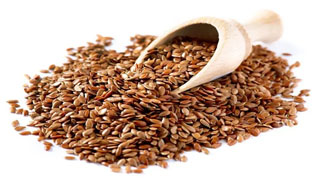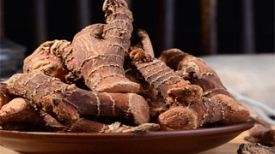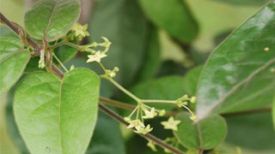
1. Alias
Hu Ma Zi, flaxseed, wall lice Hu Ma, and Da Hu Ma.
2. Plant morphology
Annual herb, 30-100 cm tall. The stem is upright, branched at the top, slightly woody at the base, and has longitudinal stripes on the surface. Single leaves alternate, with no or nearly no stem; The leaves are linear or linear lanceolate, with a gradually pointed tip and a gradually narrowing base. They are entire and often have three leaf veins. Flowers grow only at the top of branches and upper leaf axils; Sepals 5, persistent; Petals 5, blue or white, inverted or broadly inverted, apex nearly circular, slightly concave, base gradually narrowed, margin slightly wavy notch; 5 stamens, alternate with petals, anthers linear, longitudinally split, filaments slender, linear and flattened, base gradually swollen, slightly triangular, 5 degenerated stamens, leaving only tooth shaped traces, alternate with stamens; The ovary has 5 chambers, each containing 2 ovules. The style is 5, separated, and the stigma is linear. The capsule is spherical, slightly flattened, light brown, and has 5 lobes at the top when mature. The seeds are flat, oval or elliptical in shape, yellow brown or dark brown, and glossy. The flowering period is from June to July, and the fruiting period is from July to September.
3. Origin distribution
Cultivated throughout the country. Distributed in Heilongjiang, Jilin, Liaoning, Inner Mongolia and other places.
4. Harvesting and processing
When the autumn fruits are ripe, harvest the plants, sun dry them, seed them, remove impurities, and then sun dry them.
5. Characteristics of medicinal herbs
Flat oval shape, 4-7 millimeters long and 2-3 millimeters wide. The surface is reddish brown or grayish brown, smooth and glossy, with one end dull and round, and the other end pointed and slightly skewed. Small concave spots can be seen under a magnifying glass. The navel is located in the concave area at the tip, the ridge is located on one edge, the seed coat is thin and brittle, the endosperm is thin film shaped, brown, the cotyledons are 2, yellow white, and rich in oil. After soaking in water, the mucinous substance in the seed coat and epidermis expands into a transparent mucinous membrane, surrounding the entire seed. Qi is absent, chewing it has a bean like odor. Full, shiny, and reddish brown in color are preferred.
6. Sexual Taste Returning to the Classics
Sweet taste, gentle nature. Return to the lung meridian, liver meridian, and colon meridian.
7. Effect and Function
Moisturize dryness and dispel wind. Belonging to the subcategory of laxative drugs, it is a moisturizing medicine.
8. Clinical application
Used for treating diseases such as wind and scabies, dry and itchy skin, yin deficiency and blood deficiency, intestinal dryness and constipation, and hair withering and shedding; In addition, it can also be used for symptoms such as blood deficiency headache, dizziness, leprosy, and pulmonary dryness cough. Boil and consume, with a dosage of 9-15 grams; Or apply an appropriate amount externally.
9. Pharmacological research
It has the functions of mild diarrhea, cancer prevention, lubrication, mild stimulation, and blood lipid regulation. It can be used to treat local inflammation, and can also prevent hyperlipidemia or atherosclerosis. Attention, due to the presence of cyanogenic glycosides, precautions should be taken to avoid toxic side effects.
10. Chemical composition
It mainly contains flaxseed oil and 30% to 40% fatty oil. The main components of the oil are linoleic acid, alpha linolenic acid, oleic acid, nutmeg acid, palmitic acid, and also contain geranylgeraniol.
11. Usage taboos
Weak stomach, slippery stool, and pregnant women should avoid taking it.
12. Compatibility prescription
① To treat dry and scaly skin in the elderly: 90g of sesame seeds, 90g of Angelica sinensis, and 30g of purple grass. Make honey pills. Take 9 grams per dose, with boiled water, twice a day. (National Compilation of Chinese Herbal Medicines)
② Treatment for allergic dermatitis and skin itching: 60 grams each of flaxseed, white fresh skin, and ground bone skin. Make honey pills. Take 9 grams per dose, with boiled water, twice a day. (National Compilation of Chinese Herbal Medicines)
③ Treating sores and eczema: 15g flaxseed, 12g fresh white skin, 15g Kochia scoparia, and 15g Sophora flavescens. Boil in water, smoke and wash the affected area. (Shandong Herbal Medicine Handbook)
④ For the treatment of elderly or post illness body deficiency and constipation: equal parts of flaxseed, angelica, and mulberry. Make honey pills, take 9 grams each time, 3 times a day. (Handbook of Chinese Herbal Medicine in Ningxia)
⑤ Treating postpartum constipation: divide flaxseed and perilla into equal parts. Joint study, take with boiling water, 9g each time, twice a day. (Handbook of Chinese Herbal Medicine in Ningxia)
⑥ Treating seborrheic hair loss: 30g fresh willow branches and 30g flaxseed kernels each. Fry and serve. (Jiangxi Journal of Chinese Herbal Medicine)
⑦ Treating scald and fire injuries: Apply flaxseed oil (sterilized at high temperature) to the affected area. (Food, Traditional Chinese Medicine, and Toilet Formula)
⊙ The content of the article is for clinical reference only. Non TCM professionals are not allowed to test drugs.


